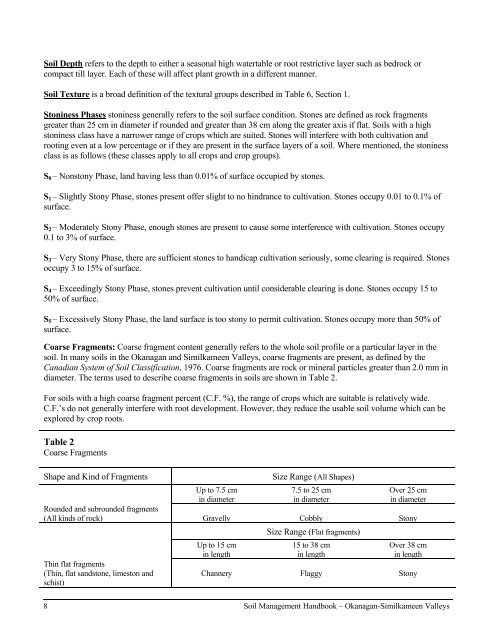Soil Management Handbook - Ministry of Agriculture and Lands
Soil Management Handbook - Ministry of Agriculture and Lands
Soil Management Handbook - Ministry of Agriculture and Lands
Create successful ePaper yourself
Turn your PDF publications into a flip-book with our unique Google optimized e-Paper software.
<strong>Soil</strong> Depth refers to the depth to either a seasonal high watertable or root restrictive layer such as bedrock or<br />
compact till layer. Each <strong>of</strong> these will affect plant growth in a different manner.<br />
<strong>Soil</strong> Texture is a broad definition <strong>of</strong> the textural groups described in Table 6, Section 1.<br />
Stoniness Phases stoniness generally refers to the soil surface condition. Stones are defined as rock fragments<br />
greater than 25 cm in diameter if rounded <strong>and</strong> greater than 38 cm along the greater axis if flat. <strong>Soil</strong>s with a high<br />
stoniness class have a narrower range <strong>of</strong> crops which are suited. Stones will interfere with both cultivation <strong>and</strong><br />
rooting even at a low percentage or if they are present in the surface layers <strong>of</strong> a soil. Where mentioned, the stoniness<br />
class is as follows (these classes apply to all crops <strong>and</strong> crop groups).<br />
S0 – Nonstony Phase, l<strong>and</strong> having less than 0.01% <strong>of</strong> surface occupied by stones.<br />
S1 – Slightly Stony Phase, stones present <strong>of</strong>fer slight to no hindrance to cultivation. Stones occupy 0.01 to 0.1% <strong>of</strong><br />
surface.<br />
S2 – Moderately Stony Phase, enough stones are present to cause some interference with cultivation. Stones occupy<br />
0.1 to 3% <strong>of</strong> surface.<br />
S3 – Very Stony Phase, there are sufficient stones to h<strong>and</strong>icap cultivation seriously, some clearing is required. Stones<br />
occupy 3 to 15% <strong>of</strong> surface.<br />
S4 – Exceedingly Stony Phase, stones prevent cultivation until considerable clearing is done. Stones occupy 15 to<br />
50% <strong>of</strong> surface.<br />
S5 – Excessively Stony Phase, the l<strong>and</strong> surface is too stony to permit cultivation. Stones occupy more than 50% <strong>of</strong><br />
surface.<br />
Coarse Fragments: Coarse fragment content generally refers to the whole soil pr<strong>of</strong>ile or a particular layer in the<br />
soil. In many soils in the Okanagan <strong>and</strong> Similkameen Valleys, coarse fragments are present, as defined by the<br />
Canadian System <strong>of</strong> <strong>Soil</strong> Classification, 1976. Coarse fragments are rock or mineral particles greater than 2.0 mm in<br />
diameter. The terms used to describe coarse fragments in soils are shown in Table 2.<br />
For soils with a high coarse fragment percent (C.F. %), the range <strong>of</strong> crops which are suitable is relatively wide.<br />
C.F.’s do not generally interfere with root development. However, they reduce the usable soil volume which can be<br />
explored by crop roots.<br />
Table 2<br />
Coarse Fragments<br />
Shape <strong>and</strong> Kind <strong>of</strong> Fragments Size Range (All Shapes)<br />
Rounded <strong>and</strong> subrounded fragments<br />
(All kinds <strong>of</strong> rock)<br />
Thin flat fragments<br />
(Thin, flat s<strong>and</strong>stone, limeston <strong>and</strong><br />
schist)<br />
Up to 7.5 cm<br />
in diameter<br />
Gravelly<br />
Up to 15 cm<br />
in length<br />
Channery<br />
7.5 to 25 cm<br />
in diameter<br />
Cobbly<br />
Size Range (Flat fragments)<br />
15 to 38 cm<br />
in length<br />
Flaggy<br />
Over 25 cm<br />
in diameter<br />
Stony<br />
Over 38 cm<br />
in length<br />
8 <strong>Soil</strong> <strong>Management</strong> <strong>H<strong>and</strong>book</strong> – Okanagan-Similkameen Valleys<br />
Stony
















